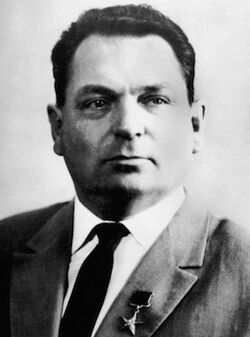Vasily Mishin facts for kids
Quick facts for kids
Vasily Mishin
|
|
|---|---|
 |
|
| Born |
Vasily Pavlovich Mishin
18 January 1917 Byvalino, Bogorodsky Uyezd, Moscow Governorate, Russian Empire
|
| Died | 10 October 2001 (aged 84) |
| Nationality | Russian |
| Citizenship | |
| Education | Moscow Aviation Institute |
| Engineering career | |
| Discipline | Engineering (mechanics) |
| Employer(s) | Soviet space program |
Vasily Pavlovich Mishin (Russian: Василий Павлович Мишин; 18 January 1917 – 10 October 2001) was a key Russian engineer in the former Soviet Union. He was a famous rocket pioneer, known for his work in the early Soviet space program. He took over the space program during a challenging time.
Contents
Early Life and Education
Vasily Mishin was born in a place called Byvalino. This was in the Bogorodsky Uyezd area of the Russian Empire. He later studied mathematics at the Moscow Aviation Institute. This institute is a well-known university for aerospace engineering.
Joining the Space Race
After World War II, Mishin was one of the first Soviet experts to visit Germany's V-2 rocket factories. He went with other important figures like Sergei Korolev. Korolev was a famous rocket designer who led the OKB-1 design bureau before Mishin. Mishin worked closely with Korolev as his deputy. They developed the first Soviet ICBM. They also worked on famous projects like the Sputnik satellites and the Vostok program. The Vostok program sent the first human, Yuri Gagarin, into space.
Leading the Soviet Space Program
In 1966, after Sergei Korolev passed away, Vasily Mishin became the head of the OKB-1 design bureau. This made him the Chief Designer for the Soviet space program. He took charge of the N1 rocket program. This program aimed to send a person to the Moon. However, the N1 rocket faced many problems. These issues were often due to not having enough money for proper testing.
Developing the N1 Rocket
Work on the N1 rocket began long before Mishin took over. The goal was to build a rocket strong enough to carry heavy loads into orbit. This was needed for the Moon landing mission. Under Korolev, there was a decision to skip some ground tests for the rocket engines. This was because funding for test facilities was limited. It also allowed for earlier test flights. Some of the problems Mishin faced later might have been avoided with more testing.
To help with engine problems during flight, a special system called KORD was created. If an engine stopped working, KORD would turn off that engine and the one opposite it. This kept the rocket balanced. KORD would also calculate how to keep the rocket on its path.
N1 Rocket Test Flights
The N1 rocket was very important for the Moon missions. However, it never flew successfully.
- The first test flight happened on February 3, 1969. It had plumbing issues, which caused a fire after one minute. But the KORD system worked, and the safety system ejected successfully.
- The second launch was on July 3. It failed just seconds after starting. The rocket fell back onto the launchpad, causing a lot of damage.
- The third N1 launch was on June 22, 1971. Many improvements were made to the KORD system and other parts. For the first time, all thirty engines of the first stage fired. However, this created too much roll (spinning). The smaller engines designed to keep it stable could not correct it. This was another problem that might have been found with more ground testing.
Final N1 Launch Attempt
For the fourth and final N1 flight, more changes were made. These included extra engines for stability and a new control system. The Soviet space program hoped to build a base on the Moon. They needed this rocket to succeed first. The launch was on November 23, 1972. The plan was for the rocket to orbit the Moon many times. It would take pictures of future landing sites before returning to Earth. This rocket flew farther than the others. But just before the first stage was supposed to separate, an engine caught fire. The whole rocket exploded. Luckily, the escape system activated before the explosion.
Challenges in Leadership
While Vasily Mishin was skilled in rocket science, he faced challenges in managing large teams. Some people believed he struggled with leading thousands of people. He was also criticized for the failures of the program to land a person on the Moon.
In May 1967, cosmonauts Yuri Gagarin and Alexei Leonov expressed concerns about Mishin's knowledge of the Soyuz spacecraft. They also mentioned his lack of cooperation with cosmonauts. Other difficulties during his time as leader included the loss of the Soyuz 11 crew. There were also failures with space stations and probes sent to Mars.
On May 15, 1974, Vasily Mishin was replaced by Valentin Glushko. This happened after all four N1 test launches failed.
Later Career and Legacy
After leaving his role as Chief Designer, Vasily Mishin continued to work in education and research. He became the head of the rocket department at the Moscow Aviation Institute.
Vasily Mishin received the title Hero of Socialist Labour for his contributions to the Soviet space program. This was a high honor. He passed away in Moscow on October 10, 2001, at the age of 84.
His personal diaries, which contained information about the space program from 1960 to 1974, were later purchased by the Perot Foundation. Parts of these diaries were donated to the National Air and Space Museum. Copies were also given to NASA.
See also
 In Spanish: Vasili Mishin para niños
In Spanish: Vasili Mishin para niños

